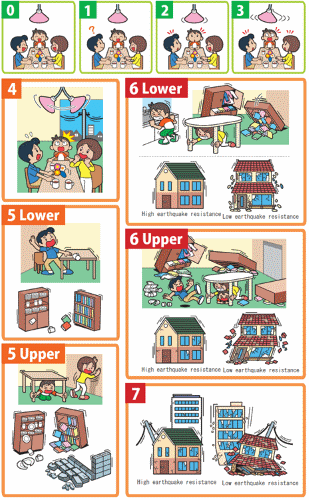Earthquakes
Japan is known for being a seismically active country. Earthquakes happen every day, but most of them cannot be felt by us. Occasionally there will be bigger quakes, and you need to be prepared for what to do. Most buildings in Japan are built to withstand large earthquakes and the populace is highly educated about them, but an earthquake is still a scary event, especially if you have never felt one before.
On this page
- Japan’s Seismic Intensity Scale and Earthquake Early Warning system
- Secondary disasters
- What to prepare
- What to do during an earthquake
- Japanese phrases to know
Japan’s Seismic Intensity Scale
Earthquakes are measured in terms of magnitude, an objective measure of scale, but Japan also has a scale called the Shindo scale which ranks earthquakes from 1-7. These numbers are based on how intensely the shaking affects humans and buildings. A 1 or 2 is barely felt, while a 6 or 7 will result in a great amount of damage to buildings. After an earthquake, you can check the Japan Meteorological Agency’s website to see how strong the shaking was in your area.

Secondary disasters
The two biggest risks you will face after an earthquake are fires and tsunami.
The 1995 Hanshin-Awaji earthquake in Kobe caused devastation due to the many fires that broke out afterwards, and the 2011 earthquake in Tohoku caused a huge tsunami that killed thousands of people.
Once an earthquake ends, turn off any stoves, heaters, and other open flames. If you are on the coast, immediately head for higher ground – don’t wait for an evacuation order.
Also, be aware that there is a chance for aftershocks to hit after the first earthquake. Usually these are smaller in scale than the first quake, but not always.
Earthquake Early Warning System
Sensors can pick up signs of an earthquake a couple of seconds before it strikes, so there is a system that sends out warnings to cell phones and television stations right before the shaking starts. Get yourself to a safe place before the shaking starts.
Prepare in advance
- Find out where the evacuation point closest to your home is.
- Decide a place to meet with your family if you have to evacuate
- Check whether any of your furniture is liable to topple over. Tall bookcases and heavy furniture are especially dangerous, but you can buy furniture stabilizing equipment at any home supply store. Do not put tall, heavy furniture in your sleeping area.
- Prepare emergency supplies and decide where they will be stored.
- Participate in disaster drills (防災訓練, bousai kunren) or evacuation drills (避難訓練, hinan kunren). Your local neighborhood association may hold such drills, or you can inquire at your local municipal hall.
When an earthquake happens
Indoors
- Even major earthquakes only last about a minute, so stay calm and hide under a table. You may want to open a door or window so you are not trapped.
- Once it ends, turn off any stoves, heaters, or other open flames. Extinguish fires that may have broken out.
- When you go outside, be calm and survey your surroundings carefully. Watch out for any objects that may fall on you.
- Move by foot to the evacuation site if necessary.
*There is a saying in Iwate called, “tendenko.” Roughly translated, it means that the only thing you should be concerned about after an earthquake is getting yourself to safety, and that every person is responsible for their own life.
Outdoors
Stay alert to any objects that could fall on you. Stay calm and cover your head. Try to move to a space not near any buildings, power lines, or other tall objects.
In an elevator
Try pressing the buttons for all floors. The elevator may have a device that automatically stops it at the nearest floor in event of an earthquake. If all else fails, continuously press the emergency button and wait for someone to contact you.
Driving
Come to a gradual stop at the side of the road, leaving the center clear for emergency vehicles to pass. Evacuate on foot, leaving the key in the vehicle and doors unlocked so someone can move it later if necessary.
In a train
Get a good grip on the straps or handrails. Don’t exit the train unless instructed to by the driver and crew, and follow all of their directions.
Information after an earthquake
Rumors can circulate quickly when accurate information is hard to get. It’s best to get your information from an official source like the TV or radio news, or official websites like the Japan Meteorological Agency or prefectural website.
Japanese phrases to know
|
Japanese |
English |
|---|---|
|
緊急地震速報 |
Earthquake early warning system. These warnings are sent to cell phones, television stations, and radio stations a few seconds before an earthquake is set to hit. Brace yourself for the shaking and cover your head. |
|
震度 |
The Shindo seismic intensity scale. Earthquakes are graded on a scale of 0-7. |
|
この地震による津波の心配はありません。 |
There is no danger of a tsunami arising from this earthquake. |
|
津波注意報・津波警報・大津波警報 |
Tsunami warnings and advisories |
このページに関するお問い合わせ
Office of International Affairs, Department of Homeland Promotion
(020-8570) 10-1 Uchimaru, Morioka City, Iwate Prefecture, JAPAN
Phone number:019-629-5765 Facsimile:019-629-5254
You can access our question form here.

